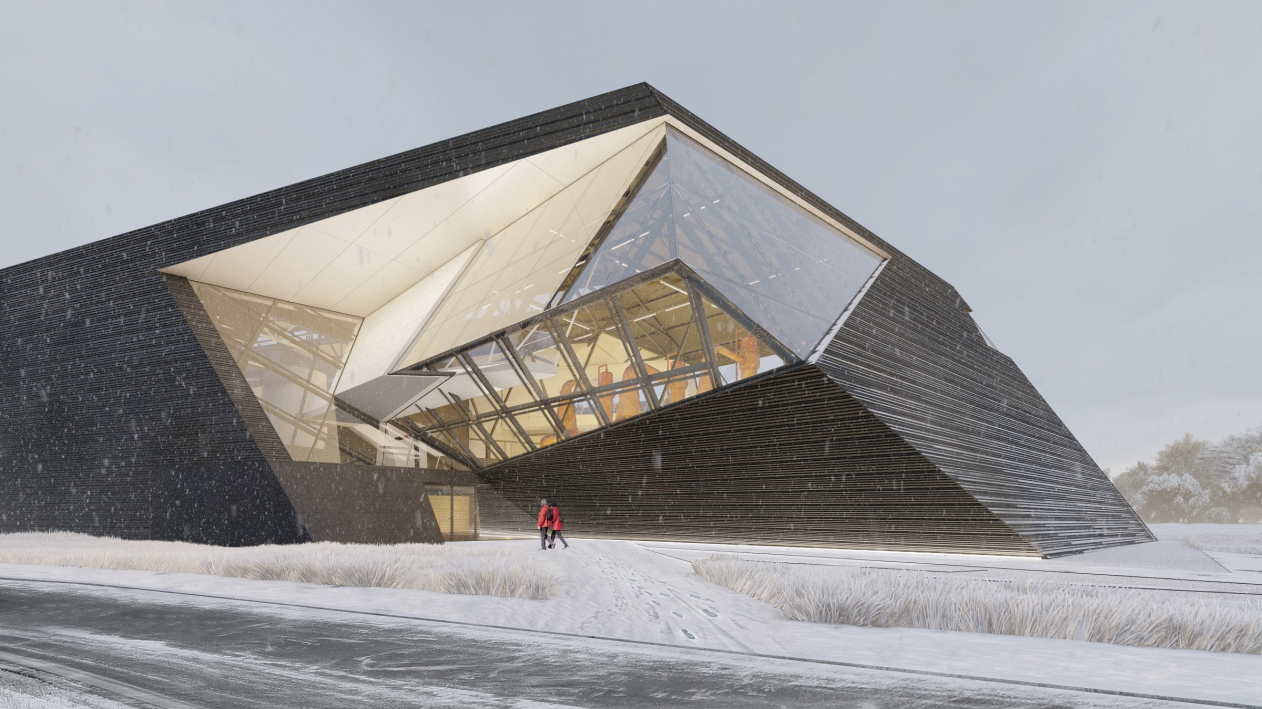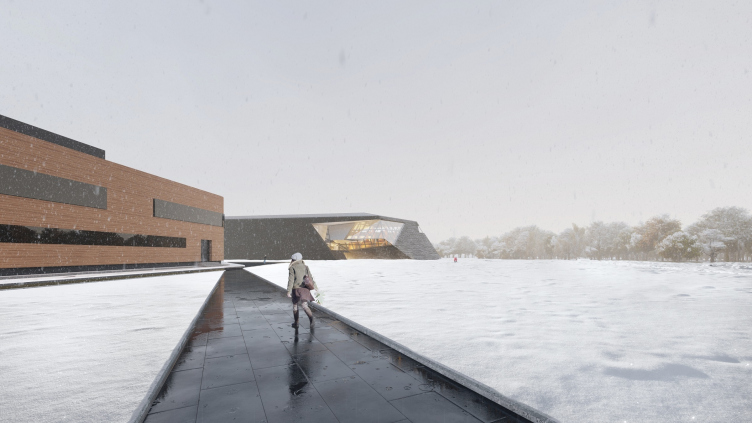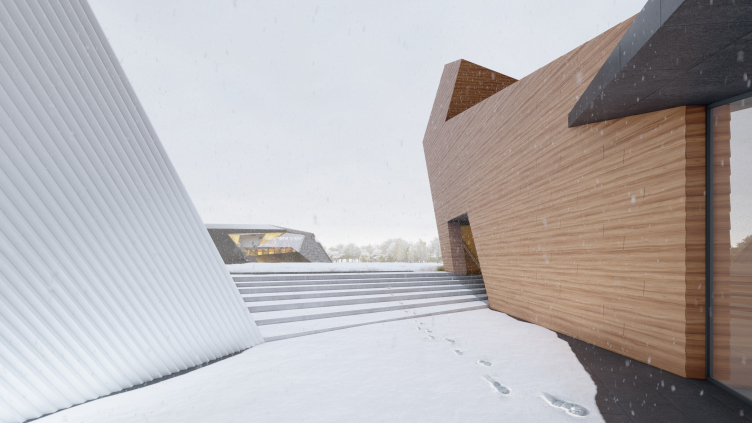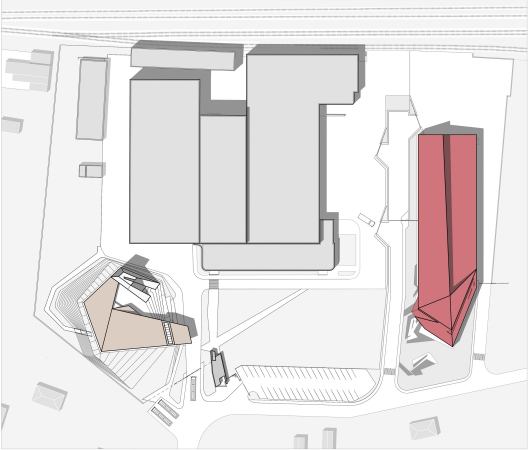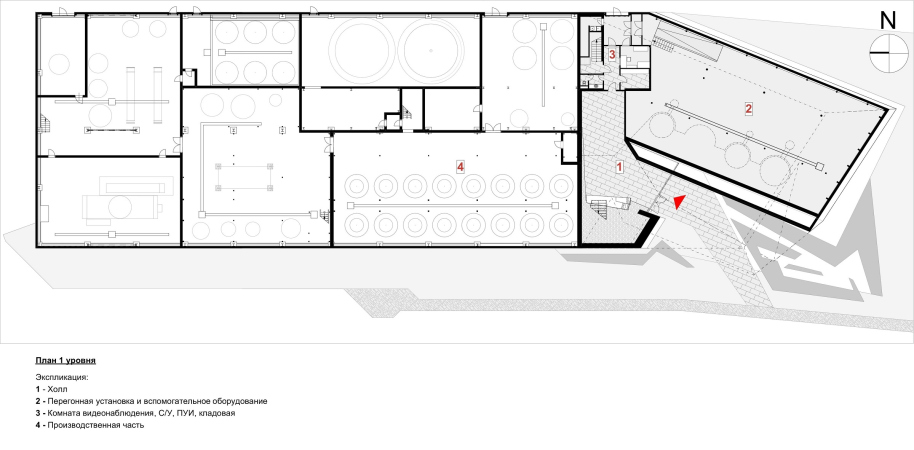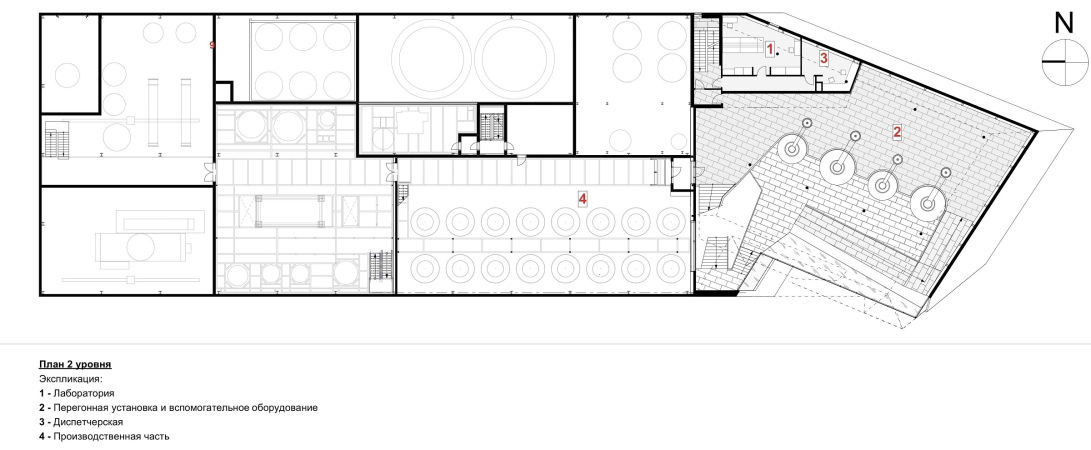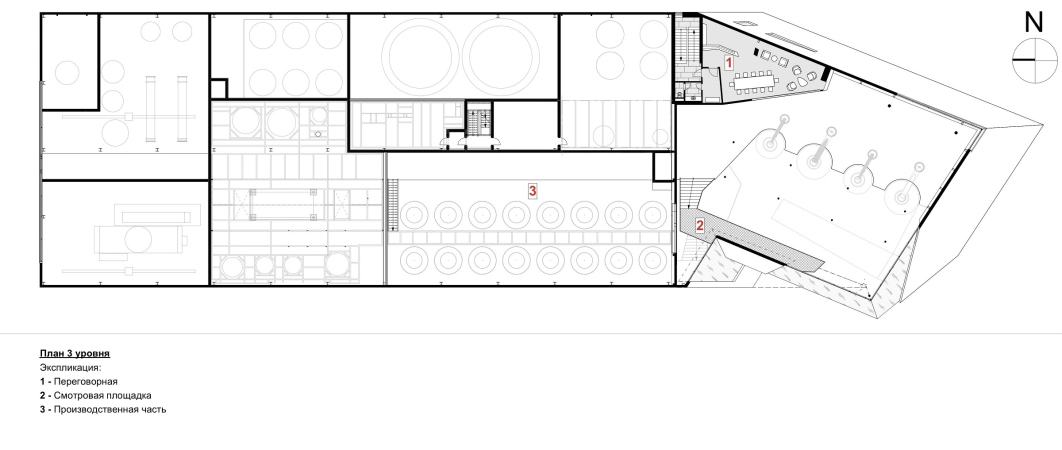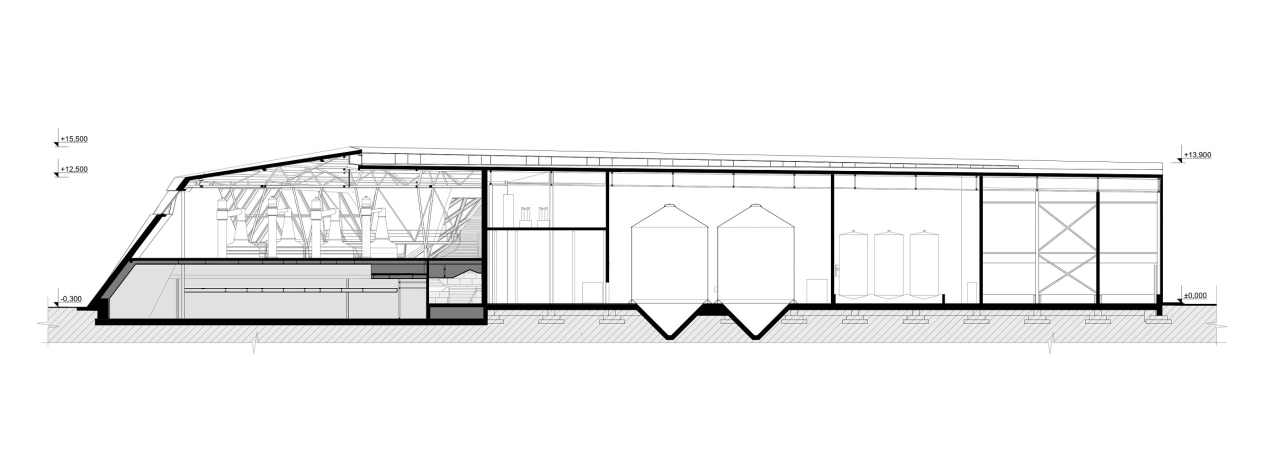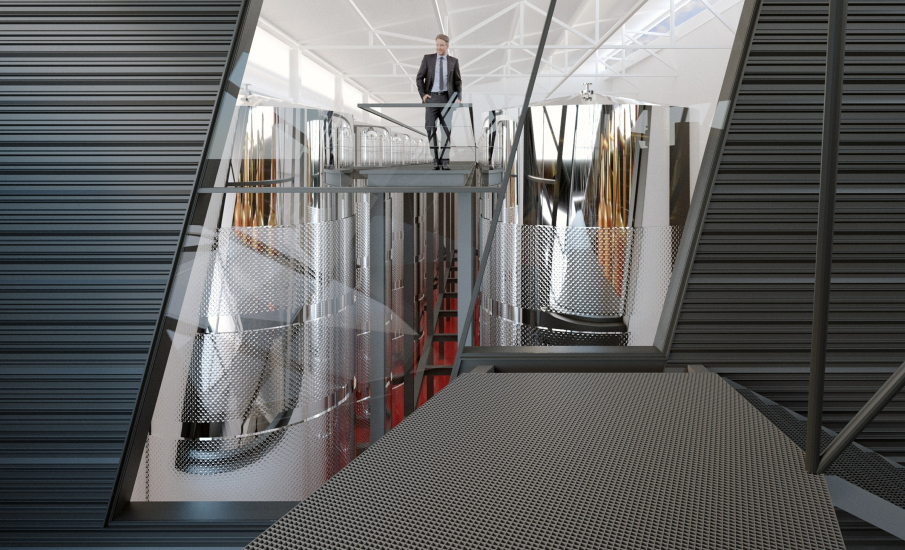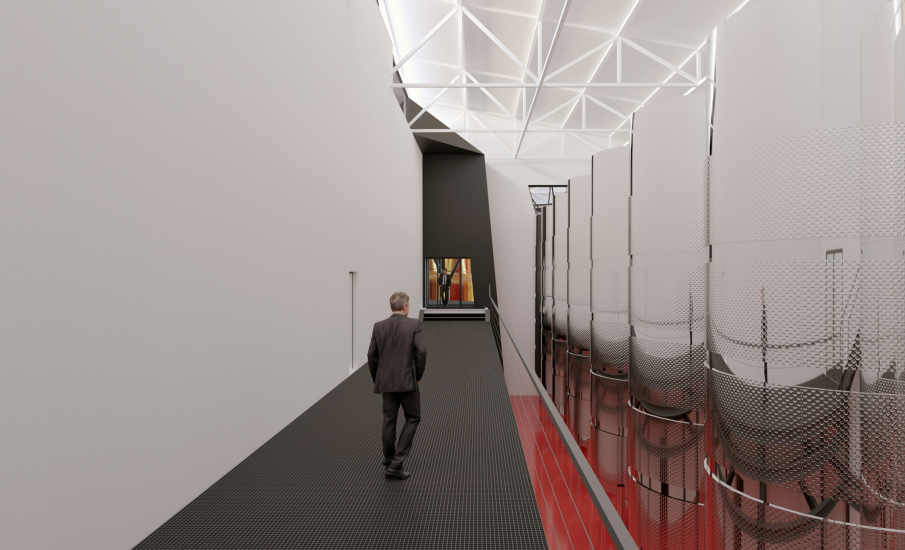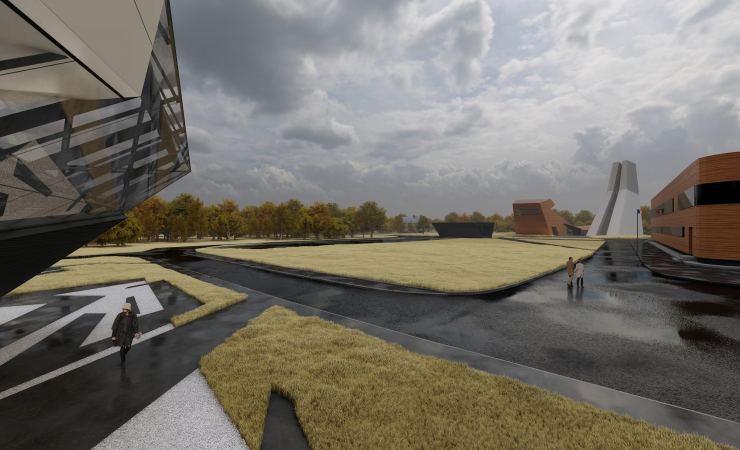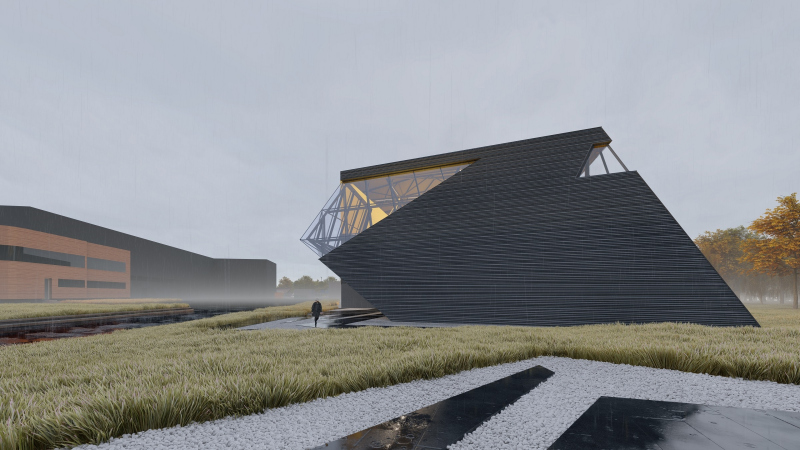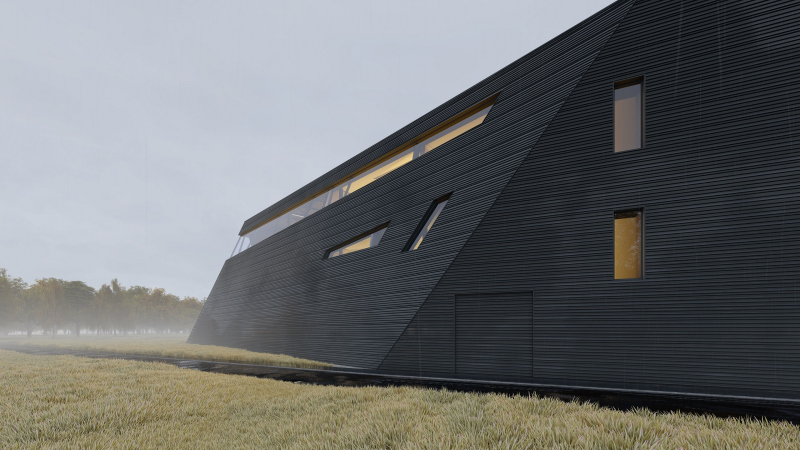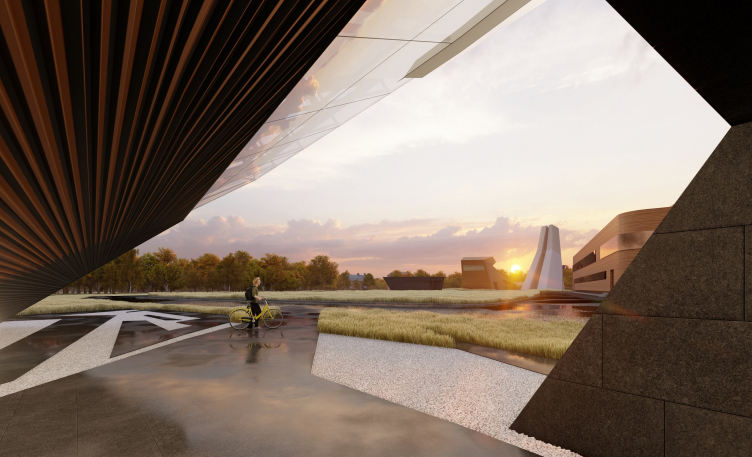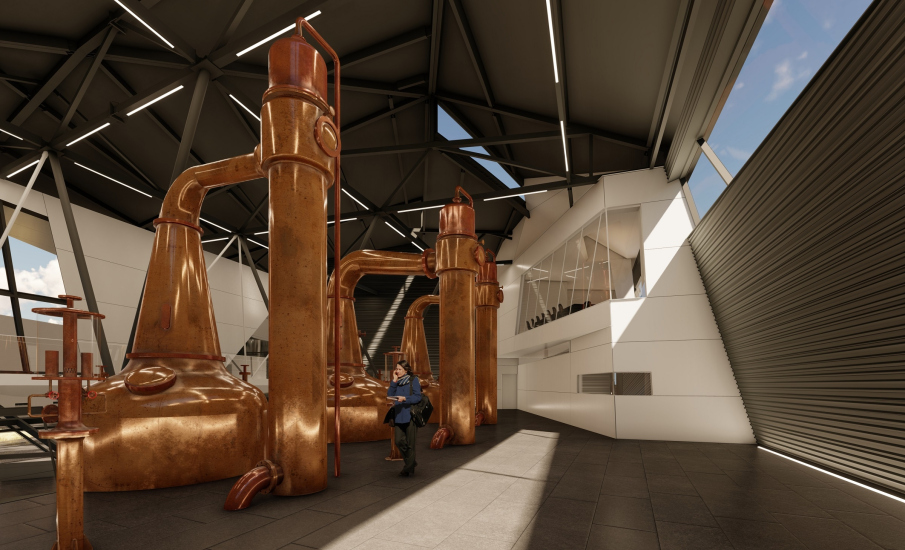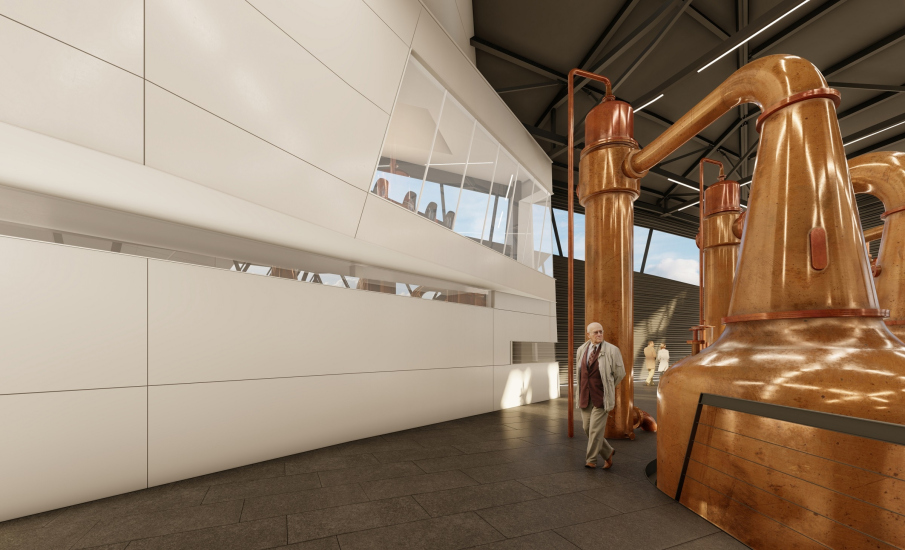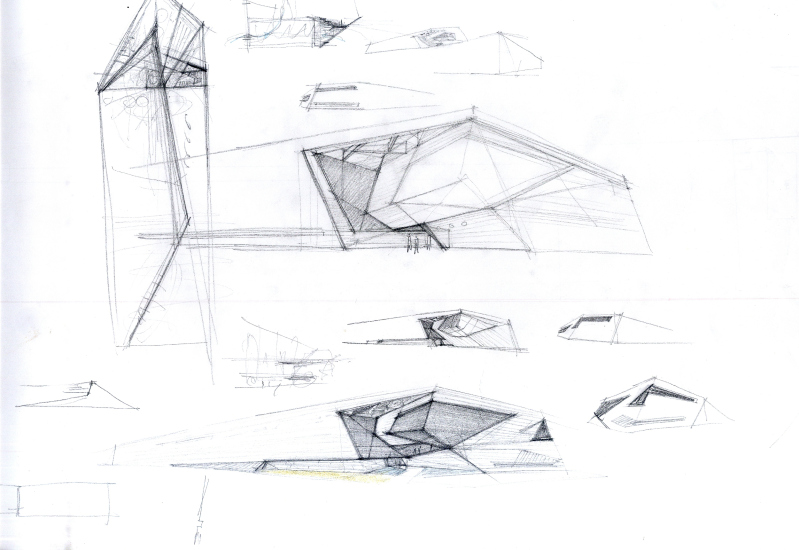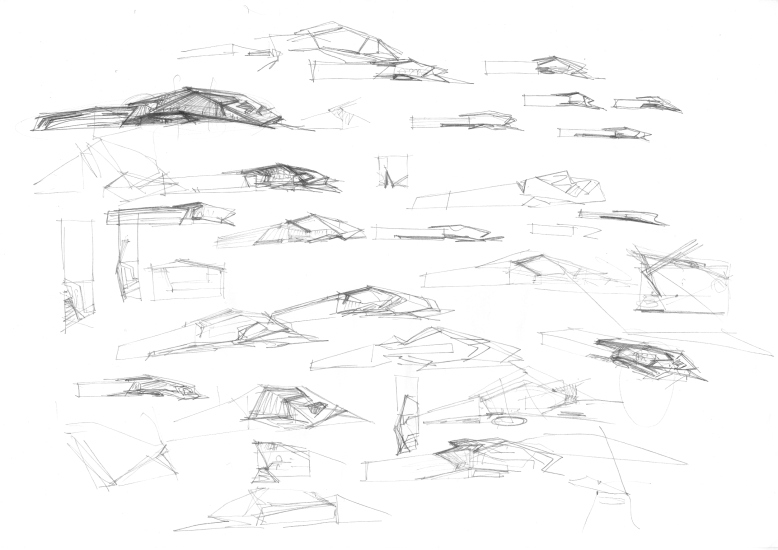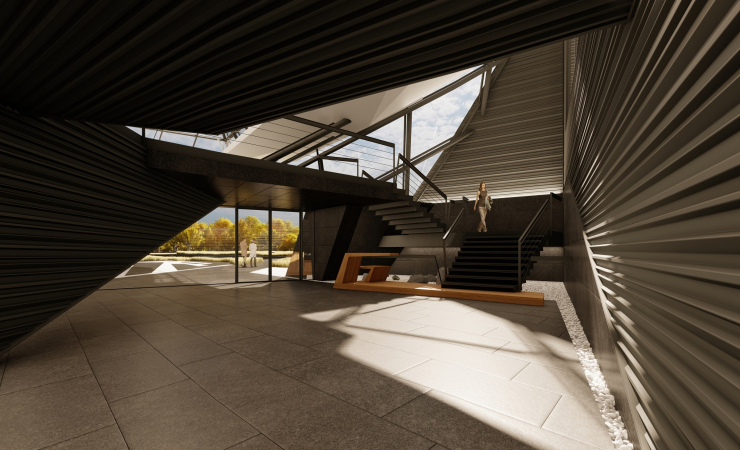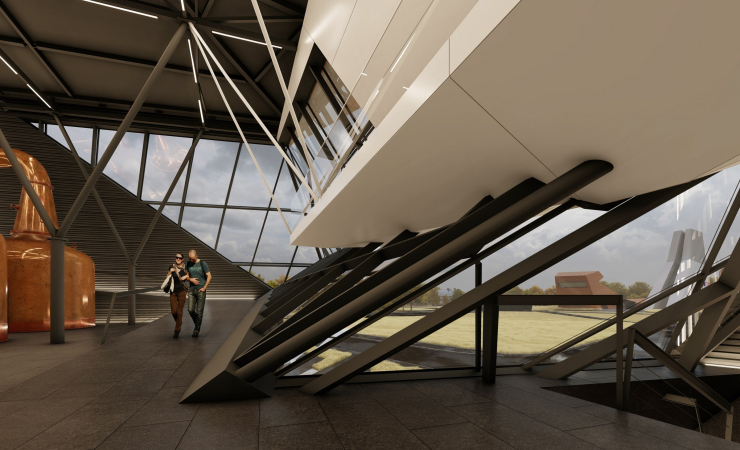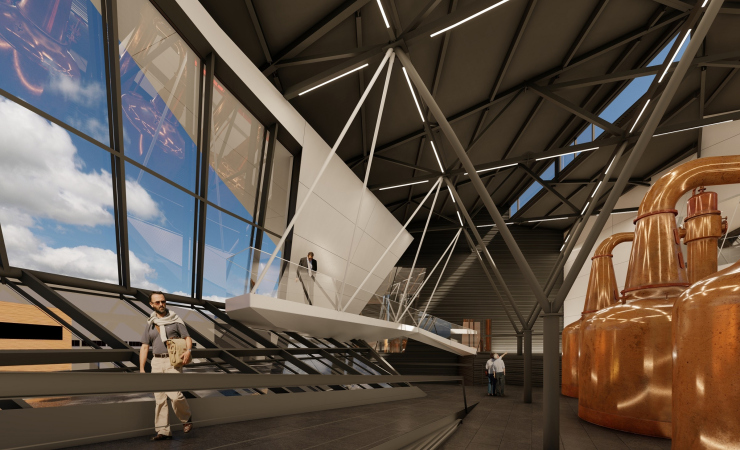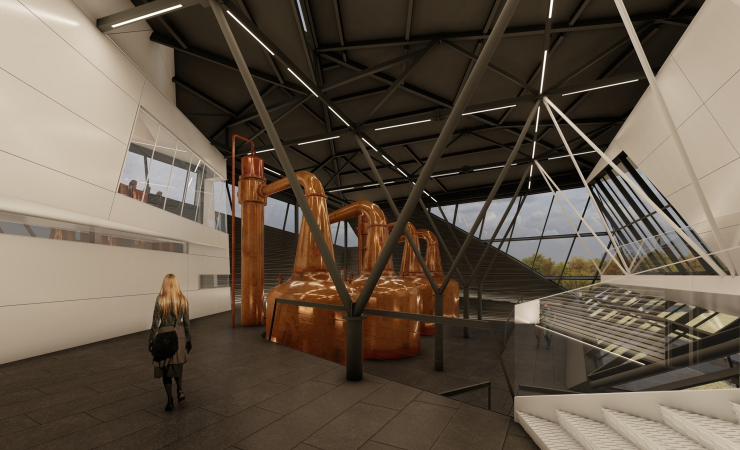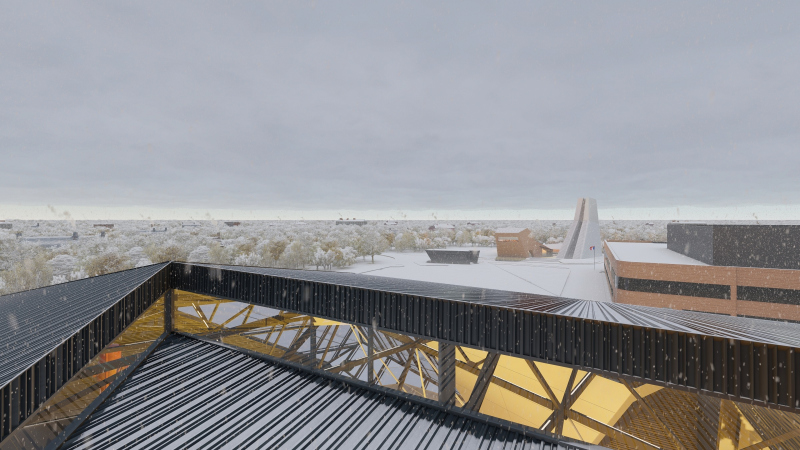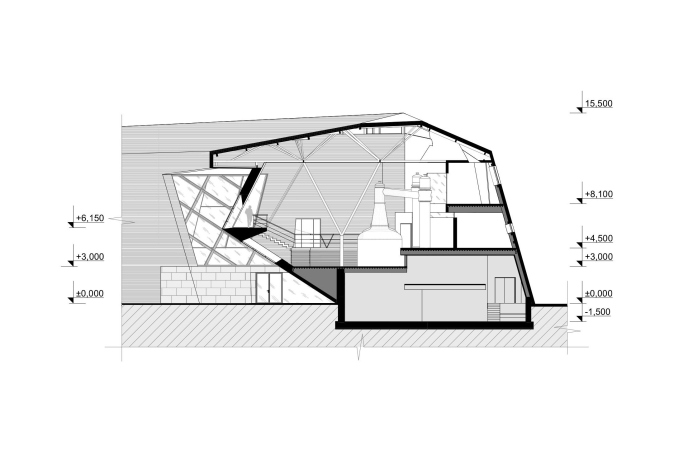At the outskirts of Chernyakhovsk, behind a railroad line, stands the cognac brewery “Alliance 1892”. A while ago, TOTEMENT / PAPER built on its territory the building of the Repository Cognac Museum combined with cask storage – the complex is not really large but it presents a carefully staged architectural dialogue: it could be interpreted as a sculpture, had it not been for the sophisticated route that runs inside of it, designed to consequently develop the visitor’s impressions. The building won a few international awards, chief of them being getting shortlisted for selection ICONIC AWARDS 2018 and for the International Architecture Award for 2018 (Chicago Athenaum); it also passed the first qualifying round of WAF2018 and was showcased in Berlin.
Distillery; view from the Cognac Museum
Copyright: © TOTEMENT/PAPER
Distillery; view from the Cognac Museum
Copyright: © TOTEMENT/PAPER
Now the land site that neighbors on the cognac brewery will host a whisky distillery. East of the cognac brewery, they are building a distillery, which is to become Russia’s first production facility of this kind; in addition, the distillery will operate on domestic raw material, processing barley and alcohol and turning them into a noble scotch drink that some spirits connoisseurs denounce as being nothing but moonlight, and some, on the other hand, have a big respect for, especially anglomaniacs, and there are lots of such people out there nowadays.
The commission to design and build the whisky distillery was again landed by Levon Airapetov and Valeria Preobrazhenskaya who demonstrated lots of professional perfectionism in the cognac brewery project. As for the architects, who have long since become quite at home with the specifics of the territory, they saw in this new task a necessity to both continue the already existing architectural ensemble, at the same time showing the differences between the buildings and addressing the specifics of the new drink and new production process. We will also note here that there are plans for building a whisky storage facility, in which the whisky will be stored in special oak casks for three years and one day at least. The storage facility has not been designed yet but it is already known that the area of the museum is 1 115 square meters, of the distillery’s 4 500 square meters, and the single-tier storage building will occupy some 16 000 square meters – the volumes are on the rise. Still more remote plans include landscaping the territory; now it is very tidy as it is – the trails are neat, the grass is trimmed, and everything looks well cared for in the European style, just like a modern production facility should look like, but the hand of a landscape designer has not yet touched it.
So! The main difference between the whisky distillery and the Cognac Museum is that its larger part is devoted to production and is only accessible to authorized personnel, essentially one or two people on duty who are supposed to control the automatic equipment, and get and assess the raw material. The production part is situated in an elongated metallic hangar that hosts bowls for various stages of fermentation, with footbridges running between them; everything is metallic white, and every little detail is taken care of: the architects are sharing that out of all the versions that were proposed by the Italian machine setters, with other things being equal, the client would inevitably opt for the most aesthetically pleasing one. But this part is totally closed-door.
Another limited-access place will be the lobby of the building, and this is also the place that most of the designers’ efforts were focused upon. The TOTEMENT / PAPER architects interpreted this part as a “head” of sorts – which is clearly readable because this “head”, glowing in the dark, crowns a rectangular “body”, and even makes half a turn in the direction of the Cognac Museum, building up emotional ties with the earlier-built edifice. “Back there [in the Cognac Museum] the two figures look as if they are involved in a dialogue, and, possibly, some curious sort of architectural dance appears there – Levon Airapetov explains – And here a stranger comes around, some sort of a wild Highlander, rough and brutal. He came here by boat with his Celtic axe, his body all covered with tattoos, and he is sort of taking stock of the surroundings”.
Indeed, the effect of a “stranger coming here by boat” is quite strong, even in spite of the fact that the building is firmly rooted in the ground – it is enough to take a look at its triangular “nose” pointed southward and looking like a cross between a modern submarine and an Ancient Greek triera. As for the elongated body of the building itself, it looks like a figure clad in some sort of hide, the likeness being enhanced by the black color and ribbed structure of the horizontal bands, upon which, as the architects are vividly demonstrating, snow will look great come winter.
Distillery; winter view
Copyright: © TOTEMENT/PAPER
Peculiar is the fact that the Scottish associations are given in this rough and brutal form, and not through the habitual kilt – but through a conditional highlander. Or “The Highlander”. The black and white tattoos, quite abstract, are also included in the paving pattern in front of the entrance, which is reflected in the glass – in the building’s “face”, and in the combination of black and white.
Distillery; view from the Cognac Museum entrance
Copyright: © TOTEMENT/PAPER
The Scotch check pattern is also present here but one has to look real hard to see it because it is hidden in the intertwining lines of the stained glass windows and does not meet the eye at all – you need the author’s clue to see it. This, of course, was the right way to go about it: who needs such straightforward associations? Yet at the same time the building definitely has a lot of soul to it, looking like a figure arrested in midair, as Levon Airapetov explains, “it must be like the body of an animal ready to make a leap. It is tense, full of attention, ready for action, and anything but relaxed”.
Video presentation of the project:
To me, this head, turned sideways, looks more like an inclusion of mountain crystal in a rock. Faceted and polished, glittering in the morning under the ray of sunlight that gets inside through a long slit in the eastern wall, and then moves inside during the day, like in a Roman pantheon, casting slanted light on various parts of the interior. At night and in the wintertime, it is lit by electric light.
Distillery; the entrance group
Copyright: © TOTEMENT/PAPER
The light accentuates the preciousness of the Crystal and everything that it has inside of it, all the more so because here, behind the glass, the most valuable parts of the production process will be located – the “cubes”, in which the whisky will spend the final stage of its distillation before being poured into oak casks and stored in them for three years. In accordance with the technology standards, the cubes must be unalloyed copper and have a rather weird shape; they look like tubs and samovars on Jean-Baptiste-Siméon Chardin still life paintings, golden red, and all round. Their shape is clearly at odds with the faceted slender black and white “frame”, creating an impression that these are treasures trapped in some sort of precious crystal. One of the most popular techniques of modern architecture that consists in creating volumetric showcases that highlight the beauty of the exhibit inside is quite appropriate in this specific instance.
The shape search passed through a multitude of options for the “showcases” – rectangular, round (in the shape of a glass), and others:
I must admit that the final version is better because it has some intrigue about it: one can see what’s inside but not the whole of it.
“The shape of the “head” and its turning angle is conditioned by the proximity of the Cognac Museum and the function of the building – Valeria Preobrazhenskaya explains – The Cognac Museum has a storage facility in it, which we don’t have here. This is why we made this cutaway in the volume, like it has an imprint of the cognac storage facility standing across from it. The buildings sort of became part of one and the same volumetric jigsaw puzzle – although there is a distance between them, they are still connected with the resonance of shape”. Yet another technique of forming almost a “secret tie” between the volumes within the ensemble is part of the code that determines the form and motivates differences and similarities inside of it.
On the one hand, this can pass unnoticed. On the other hand, if you pay attention, you will see a visible dent in the volume of the “head” – an imprint of the Cognac Museum. But initially it still seems that the crystal lobby has either been chipped away or turned on a pivot – which, essentially, gives it some resemblance to a human head that is taking stock of the surroundings. As a result, above the entrance appears a steep slope running down to the ground: there are metal and glass hanging over the incoming visitors at an acute angle. There is also a glass ledge (which also looks a little bit like a bird’s beak) that has a black ramp inside of it, treading on which one can look through the glass beneath one’s feet. Higher up, in the ledge of the “beak”, there is a white balcony – the best possible vantage point to admire the Cognac Museum. Thus, the parts of the ensemble also “exchange glances” with one another, in this instance literally, exchanging the visitors’ glances. From the inside, the balcony is supported by white metallic wire ropes, while the black ceiling, dissected by white strokes of lamps, is supported by black branching pillars (currently, the architects are struggling to make them as slender and as exquisite as possible). In addition, the metallic grille of the ceiling is not masked in any way, the inside walls decorated in the same way as the outside ones: they are covered with horizontal bands of corrugated metal – all of this is meant to highlight the unity of the inside and the outside, leaving not a single chance to relaxed comfort that is generally expected from interior design. In this instance, the atmosphere of the inside is probably as tense as it is on the outside, one moment short of sparks flowing. Such a space is not alien to a wow-effect; in its own way, it holds its own with the Cognac Museum with its sophisticated routes and an “upshot” from ground to the sky.
The graphic play of black and white planes and lines in space is truly mesmerizing, all the more so because they intersect at such different angles, and in motion their perception will be constantly changing, making us feel the space emotionally, live it through. Which is, basically, quite understandable because we are inside the “head” of the distillery, a curious “town in the snuff-box”, a place that is only accessible to a few chosen ones – so it must look unusual and justify the expectations springing from its inaccessible status. But then again, as was already said, the entrance lobby is at the same time the presentation part of the building, to which, for example, business partners can be invited in the future. So it is not for nothing that in the corner we see a white volume of the meeting room.
Of course, there is no doubt that the distillery could have actually been built as an aluminum hangar, a simple “box”. Still, however, wine, in the broad sense of the word, not to use the official term “alcoholic beverages”, is definitely a cult in its own right, and part of this cult consists of lots of distilleries, breweries, and other related buildings of designer architecture. This topic is so romanticized that now breweries (and a distillery will fit in here just as nicely) are akin to public buildings or museums; there are even guided tours of them. The project by Airapetov / Preobrazhenskaya is exactly of this kind, it is something that must be shown; it is like high-quality exciting packaging that is capable of adding extra charisma to the production that is about to be launched – like a really good label can convey the essence of wine. Well, or whisky, for that matter.

